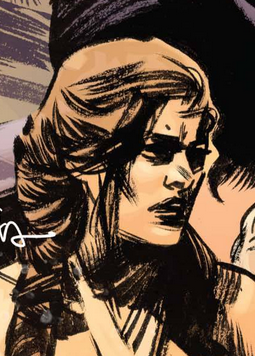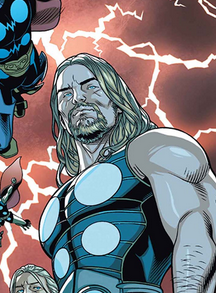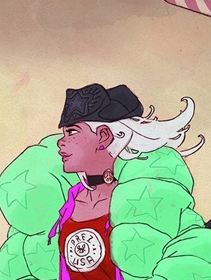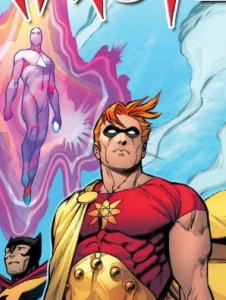Deadshirt Is Reading… is a weekly feature in which Deadshirt’s staff, contributing writers, and friends-of-the-site offer their thoughts on Big Two cape titles, creator-owned books, webcomics and more. For more of our thoughts on this week’s new comics, take a look at Wednesday’s Deadshirt Comics Shopping List and be sure to also check out our solo review of Justice League of America #1.
David Uzumeri is reading…
Written by Jason Aaron
Penciled by Chris Sprouse
Inked by Karl Story
Colored by Marte Gracia
Lettered by Joe Sabino
Marvel
“You’re talking to a frog who carries a hammer, pal. Any damn thing is possible.”
“Cosmic cops” is a concept we see a lot in comics—it’s pretty much the entire impetus for the Green Lantern and Nova Corps, but those books always seem to be a whole lot of “cosmic” and not a lot of “cops.” The past few…decades…or so of Green Lantern stories have been way more Star Wars than Hill Street Blues, and Nova hasn’t been much different. The closest we’ve gotten to the Police Procedural In Space concept is probably the Green Lanterns’ appearance in Final Crisis, where they actually investigated a murder, sealed off a crime scene, and even dealt with internal affairs. Geoff Johns and Peter J. Tomasi’s runs, though, never really approached that concept, preferring instead to deal with cosmic worldbuilding, ancient conspiracies, and giant yellow fear bugs.
When Secret Wars was formulated, one of the core conceits of Battleworld would be that Doom’s cops—his enforcers—would all be Thors. In the criminal justice system of Battleworld the people are represented by two separate, yet equally important entities. The Thors who investigate crime, and the Sheriff Strange who prosecutes the offenders. These are their stories.
Which is to say, Thors is in every way a police procedural, reveling in every single cop show cliché it can possibly fit in twenty pages, except that there are hammers instead of badges, lightning bolts instead of bullets, and serial killers who only murder iterations of a single person. A continuation of the kind of vibe Aaron built with the cosmic murder investigation that formed the core of last year’s Original Sin, Thors ratchets that up to eleven, with a clever hook that ties it both to Thor’s central mythology as a character and also to current events in the on-hiatus-for-this-event Thor ongoing, which Aaron also writes.
Chris Sprouse is, as always, ably abetted by inker Karl Story, and he’s an interesting but incredibly capable choice for this series. He’s been largely associated with pulp pastiches, to a certain extent—one of his major coming-out parties as an artist was Tom Strong with Alan Moore, and he drew last year’s Multiversity: Society of Super-Heroes with Grant Morrison—and rather than taking place in a sort of lost 1940s, Thors is inextricably set both in the realm of fantasy and in the now. The thing is, Sprouse is a great artist with clear storytelling and a vivid imagination, so he kills it.
It’s almost a shame this is a limited series, since Aaron nails the big-ideas sci-fi super-cop book I’ve always wanted to read. I really hope he does something else in this vein after the event concludes, but for now, this is a fine feast in the mead hall of cop Valhalla.
Max Robinson is reading…
Written by Mark Russell
Art by Ben Caldwell
Colored by Jeremy Lawson
Lettered by Travis Lanham
DC Comics
“Basically our choice is between someone who betrays our core values…or someone who spent their college years drinking milk and making model airplanes”
Every once in a while a first issue really, truly surprises you. Such is the case with the debut issue of DC’s reimagined Prez, one of the most delightful and intelligent comics I’ve ever read. Originally an offbeat Joe Simon creation, Prez is one of those old comic concepts that seems to exist solely for self-deprecatory reimaginings or sight gags. Mark Russell and Ben Caldwell’s take on the concept of a teen president is certainly (and frequently) funny, but more than that, it’s smart and sharp. The 2015 incarnation of Prez centers around Beth Ross, a teenage fry cook who inadvertently becomes a third party presidential candidate through a series of events involving a viral video, an influential YouTube personality, Anonymous, and a shadowy cabal of corporate personhoods with holograms for faces.
This first issue is loaded with story and, amazingly, it flows beautifully. In the span of a single issue, Russell pointedly satirizes right wing contempt towards the poor, fast food consumption, our obsession with wealth and celebrity, healthcare, the ever increasing profile of social media, and the insidiousness of government lobbyists. Prez #1 doesn’t beat around the bush when it comes to what it wants to say about the world around us and the authority figures who’ve failed us both left and right. Although there’s a funhouse quality to the hyper-exaggerated future DCU place in which it takes place, Beth feels like a real person with her own values, problems, and ambitions. Even though we only get a glimpse at The Teen Who Would Be Prez, I already know that I’d vote for her.
What really makes this such an astonishing first issue is Caldwell’s art, which bombards the reader with nonstop visual information. During a debate on a faux-Fox News channel, we see holographic representations of rising/lowering approval ratings alongside a hovering SPONSORED CONTENT disclaimer beside a perky blonde host. Serious thought went into the designs of Prez, and it shows on every page. Jeremy Lawson’s color work here is perfectly tailored to Caldwell’s pages, giving everything an in-your-face neon futurism.
Aside from a single (intriguing) reference to The Wayne Foundation, this is a DC book entirely devoid of superheroes. Imagine the glowing lovechild of Transmetropolitan‘s glib sci-fi weirdness and the quirky humanism of Unbreakable Kimmy Schmidt: That’s Prez. I sincerely hope the series’ charm, wit and imagination are enough to help it find a healthy audience.
Joe Stando is reading…
Written by Marc Guggenheim
Art by Carlos Pacheco (pencils) and Mariano Taibo (inks)
Colored by Frank Martin
Lettered by Joe Caramagna
Marvel
“And you talk too much. I killed you sometime between ‘extraterrestrial’ and ‘crystal.’”
When the solicit for Squadron Sinister described it as being similar to Sons of Anarchy and The Sopranos, I figured I should check it out. I have some degree of affection for the characters, but more than anything I wanted to see if there were actually any commonalities at all between the prestige era of television drama and this comic, or if they were just throwing buzzwords around.
And it sort of is like those popular television programs! It’s a book that follows the Squadron Sinister, a villainous crew of pastiches of the Justice League, as they deal with threats from both outside and within. The Squadron Sinister/Supreme has been through a number of different incarnations over the years, but this one is a pretty straight “what if Superman and friends were evil?” story. The Squadron is somewhere between a set of dictators and an organized crime family in how they operate, and they seem to be the most expansion-minded ruling group in Battleworld so far. This brings them into conflict with champions of neighboring areas, as well as the Thors and each other, as at least three members of the team have secret alliances or questionable loyalties.
It’s unabashedly a story about villains, and that has ups and downs. The scenes we get of everyone sniping at each other in conversation and talking shit behind each other’s back are fun, and we get a pretty good feel for who they are, both themselves and as counterpoints to classic DC characters. But it sort of strays too far into the edgy, “you can’t HANDLE this” tone that Marvel’s MAX imprint used and abused. It was fun seeing JMS’ faux-deep take on the team get taken down, but between that, some arms getting ripped off, and a vaporized face, the violence feels cheap. Iron Thor is a gorgeous design and a clever character to use for a bit part, but the reveal of his murder occurring during mid-air sex between Hyperion and Warrior Woman? Trying too hard. Pacheco’s art is great and there’s a lot to like about the story, but rather than an iconic, genre-defining show like The Sopranos, this sometimes feels like a Showtime network knockoff, emulating the surface elements of some of the best dark superhero stories without a deeper message.
Still, there was plenty I enjoyed in this book, and it does feel like one of the more dense, built tie-ins. This first issue alone introduces at least five separate conflicts without feeling too forced, a feat that would make Paul Levitz weep. The art is great, and there are a bunch of wonderful grace notes, like Hyperion donning a domino mask when in public. There’s a lot to like here, but like most gritty dramas on TV these days, it’s definitely not for everyone.
Kayleigh Hearn is reading…
 Mad Max: Fury Road: Furiosa #1
Mad Max: Fury Road: Furiosa #1
Written by George Miller (story), Nico Lathouris and Mark Sexton (script)
Art by Mark Sexton, Tristan Jones, and Szymon Kurdranski
Colored by Mike Spicer
Vertigo
“…But who’s going to protect us from her?”
I don’t usually buy movie prequel comics. By nature, they’re somewhat disposable—the literary equivalent of a 7-Eleven cup with an actor’s face printed on it. If the comic’s backstory was really necessary, it’d be depicted in the film, so with prequel tie-in comics the best you can really hope for is a book that feels like a really good deleted scene. But Mad Max: Furiosa isn’t just any tie-in comic—it happens to be about Imperator Furiosa, who, as played by Charlize Theron, is one of the biggest breakout characters of the year. An instantly iconic character, Furiosa’s popularity can already be seen on t-shirts, Twitter handles (surely you know at least one woman calling herself “Imperator”), and pin-ups by professional artists. Mad Max: Furiosa #1 could have been a fun read for anyone looking to slake their Furiosa thirst, but it is instead an empty, deeply disappointing comic.
The biggest problem is that Furiosa isn’t really about Furiosa at all—it’s about the Five Wives, the healthy “breeders” kept in sexual slavery by the tyrant Immortan Joe. So yes, be warned, this is a book about rape. The assaults are kept off-page, but the story and dialogue are filled with horrors like unwanted pelvic exams, attempts at self-performed abortion, and the fondling of an underage girl. To their credit, the creative team of Lathouris, Sexton, Jones, and Kudranski don’t attempt to make any of this erotic or palatable, but it’s pretty damn badly timed, given that Mad Max: Fury Road and the controversial latest season of Game of Thrones have sparked debates over the depictions (or non-depictions) of rape in pop culture.
Look, we came to Mad Max: Fury Road for the glorious car chases and stayed for its fantastic worldbuilding and confident feminism; no one came away from it thinking, “You know, I want to see Immortan Joe getting shots for erectile dysfunction, or The Dag talking about how he forced his fist in her mouth.” (Also, what’s with the jokes using implied homosexuality as the punchline? Where did that even come from?) It’s squirm-inducing, unnecessary stuff, especially for a comic based on a film that was so lean it didn’t have a speck of narrative fat.
And what of Furiosa? With her, at least, the writing team seems to understand that less is more. Her backstory remains largely shrouded in mystery, and Sexton, Jones, and Kurdranski capture her likeness without slavishly copying Theron’s appearance. The artwork is dark and grimy, appropriate for the content, but a far cry from the film’s stunning color palette and cinematography. Ultimately, I can’t imagine this being a must-read for any fan of Mad Max or Furiosa. I don’t usually buy movie prequel comics. I wish I hadn’t bought this one.
Thanks for reading about what we’re reading! In the meantime, what are you reading? Tell us in the comments section, on Twitter or on our Facebook Page!




